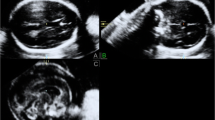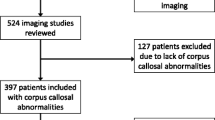Abstract
Objective
Posterior fossa size and cerebellar weight and volume are reduced in Chiari type II malformation (CII). This is assumed to affect the cerebellum uniformly. We quantified the presumed reduction in vermis size on magnetic resonance imaging (MRI).
Methods
A midsagittal brain MRI slice was selected from each of 68 participants with CII (mean age 13 years). Control participants were 28 typically developing children (mean age 14.1 years). Midsagittal surface areas occupied by the intracranial fossa, posterior fossa, vermis, and its lobules were measured.
Conclusions
Mean posterior fossa area was significantly smaller (P<0.003), although mean vermis area was significantly larger (P<0.0001), in participants with CII than in control participants. This expansion involved vermis lobules I–V and VI–VII areas (P<0.0001). The midsagittal vermis was expanded and not reduced in size in participants with CII. This is attributed to compressive displacement of midline structures within the confines of a small posterior fossa.





Similar content being viewed by others
References
Altman DG (1995) Practical statistics for medical research. Chapman & Hall, London
Aylward EH, Reiss A (1991) Area and volume measurement of posterior fossa structures in MRI. J Psychiatr Res 25:159–168
Barkovich AJ (2000) Congenital malformations of the brain and skull/congenital anomalies of the spine. In: Barkovich AJ (ed) Pediatric neuroimaging. Lippincott Williams & Wilkins, Philadelphia, PA, pp 330–337
Berquin PC, Giedd JN, Jacobsen LK, Hamburger SD, Krain SL, Rapoport JL, Castellanos FX (1998) Cerebellum in attention-deficit hyperactivity disorder: a morphometric MRI study. Neurology 50:1087–1093
Boltshauser E, Schneider J, Kollias S, Waibel P, Weissert M (2002) Vanishing cerebellum in myelomeningocoele. Eur J Paediatr Neurol 6:109–113
Brocklehurst G (1969) A quantitative study of a spina bifida foetus. J Pathol 99:205–211
Chiari H (1891) Ueber Veraenderungen des Kleinhirns infolge von Hydrocephalie des Grosshirns. Dtsch Med Wochenschr 17:1172–1175
Christophe C, Dan B (1999) Magnetic resonance imaging cranial and cerebral dimensions: is there a relationship with Chiari I malformation? A preliminary report in children. Eur J Paediatr Neurol 3:15–23
Courchesne E, Saitoh O, Yeung-Courchesne R, Press GA, Lincoln AJ, Haas RH, Schreibman L (1994) Abnormality of cerebellar vermian lobules VI and VII in patients with infantile autism: identification of hypoplastic and hyperplastic subgroups with MR imaging. Am J Roentgenol 162:123–130
Courchesne E, Karns CM, Davis HR, Ziccardi R, Carper RA, Tigue ZD, Chisum HJ, Moses P, Pierce K, Lord C, Lincoln AJ, Pizzo S, Schreibman L, Haas RH, Akshoomoff NA, Courchesne RY (2001) Unusual brain growth patterns in early life in patients with autistic disorder: an MRI study. Neurology 57:245–254
Dennis M, Edelstein K, Hetherington R, Copeland K, Frederick J, Blaser SE, Kramer LA, Drake JM, Brandt M, Fletcher JM (2004) Neurobiology of perceptual and motor timing in children with spina bifida in relation to cerebellar volume. Brain 127:1–10
Emery JL, Gadsdon DR (1975) A quantitative study of the cell population of the cerebellum in children with myelomeningocele. Dev Med Child Neurol 15(Suppl 29):20–25
Fletcher JM, Copeland K, Frederick JA, Blaser SE, Kramer LA, Northrup H, Hannay HJ, Brandt ME, Francis DJ, Villarreal G, Drake JM, Laurent JP, Townsend I, Inwood S, Boudousquie A, Dennis M (2005) Spinal lesion level in spina bifida: a source of neural and cognitive heterogeneity. J Neurosurg 102:268–279
Hardan AY, Minshew NJ, Harenski K, Keshavan MS (2001) Posterior fossa magnetic resonance imaging in autism. J Am Acad Child Adolesc Psych 40:666–672
Harding BN, Copp AJ (2002) Malformations. In: Graham DI, Lantos PL (eds) Greenfield’s neuropathology. Edward Arnold, London, pp 376–386
Hori A (2002) Chiari anomaly type II without cerebellar herniation. Acta Neuropathol 105:193–194
Jacobsen LK, Giedd JN, Berquin PC, Krain AL, Hamburger SD, Kumra S, Rapoport JL (1997) Quantitative morphology of the cerebellum and fourth ventricle in childhood-onset schizophrenia. Am J Psychiatry 154:1663–1669
Jernigan TL, Tallal P (1990) Late childhood changes in brain morphology observable with MRI. Dev Med Child Neurol 32:379–385
Just M, Schwarz M, Ludwig B, Ermert J, Thelen M (1990) Cerebral and spinal MR—findings in patients with postrepair myelomeningocele. Pediatr Radiol 20:262–266
Lesnik PG, Ciesielski KT, Hart BL, Benzel EC, Sanders JA (1998) Evidence for cerebellar-frontal subsystem changes in children treated with intrathecal chemotherapy for leukemia: enhanced data analysis using an effect size model. Arch Neurol 55:1561–1568
Levitt JG, Blanton R, Capetillo-Cunliffe L, Guthrie D, Toga A, McCracken JT (1999) Cerebellar vermis lobules VIII–X in autism. Prog Neuropsychopharmacol Biol Psychiatry 23:625–633
McLone DG, Knepper PA (1989) The cause of Chiari II malformation: a unified theory. Pediatr Neurosci 15:1–12
Miller RG (1981) Simultaneous statistical inference. Springer, Berlin Heidelberg New York, pp 6–8
Mostofsky SH, Mazzocco MM, Aakalu G, Warsofsky IS, Denckla MB, Reiss AL (1998) Decreased cerebellar posterior vermis size in fragile X syndrome: correlation with neurocognitive performance. Neurology 50:121–130
Mostofsky SH, Reiss AL, Lockhart P, Denckla MB (1998) Evaluation of cerebellar size in attention-deficit hyperactivity disorder. J Child Neurol 13:434–439
Murakami JW, Courchesne E, Press GA, Yeung-Courchesne R, Hesselink JR (1989) Reduced cerebellar hemisphere size and its relationship to vermal hypoplasia in autism. Arch Neurol 46:689–694
Nopoulos PC, Ceilley JW, Gailis EA, Andreasen NC (1999) An MRI study of cerebellar vermis morphology in patients with schizophrenia: evidence in support of the cognitive dysmetria concept. Biol Psychiatry 46:703–711
Pilu G, Romero R, Reece EA, Goldstein I, Hobbins JC, Bovicelli L (1988) Subnormal cerebellum in fetuses with spina bifida. Am J Obstet Gynecol 158:1052–1056
Piven J, Saliba K, Bailey J, Arndt S (1997) An MRI study of autism: the cerebellum revisited. Neurology 49:546–551
Raz N, Torres IJ, Spencer WD, White K, Acker JD (1992) Age-related regional differences in cerebellar vermis observed in vivo. Arch Neurol 49:412–416
Raz N, Dupuis JH, Briggs SD, McGavran C, Acker JD (1998) Differential effects of age and sex on the cerebellar hemispheres and the vermis: a prospective MR study. Am J Neuroradiol 19:65–71
Roche AF, Mukherjee D, Guo SM, Moore WM (1987) Head circumference reference data: birth to 18 years. Pediatrics 79:706–712
Saitoh O, Courchesne E, Egaas B, Lincoln AJ, Schreibman L (1995) Cross-sectional area of the posterior hippocampus in autistic patients with cerebellar and corpus callosum abnormalities. Neurology 45:317–324
Schmahmann JD (2000) MRI atlas of the human cerebellum. Academic, San Diego, CA
Schmitt JE, Eliez S, Warsofsky IS, Bellugi U, Reiss AL (2001) Enlarged cerebellar vermis in Williams syndrome. J Psychiatr Res 35:225–229
Sener RN (1995) Cerebellar agenesis versus vanishing cerebellum in Chiari II malformation. Comput Med Imaging Graph 19:491–494
Shah SA, Doraiswamy PM, Husain MM, Figiel GS, Boyko OB, McDonald WM, Ellinwood EH, Krishnan KRR (1991) Assessment of posterior fossa structures with midsagittal MRI: the effects of age. Neurobiol Aging 12:371–374
SPSS (2001) Statistical package for the social sciences for windows. SPSS, Chicago, IL
Tsai T, Bookstein FL, Levey E, Kinsman SL (2002) Chiari-II malformation: a biometric analysis. Eur J Pediatr Surg 12(Suppl 1):S12–S18
Van Allen MI, Kalousek DK, Chernoff GF, Juriloff D, Harris M, McGillivray BC, Yong S, Langlois S, MacLeod PM, Chitayat D, Friedman JM, Wilson RD, McFadden D, Pantzar J, Ritchie S, Hall JG (1993) Evidence for multi-site closure of the neural tube in humans. Am J Med Genet 47:723–743
Variend S, Emery JL (1973) The weight of the cerebellum in children with myelomeningocele. Dev Med Child Neurol 15(Suppl 29):77–83
Acknowledgements
We thank Drs. Daune L. MacGregor, Teresa To, and Pheroze Bharucha, Miss Dawn Greer, and Mrs. Irit Dror for their help and support. Financial support: (1) Research training competition award, The HSC; (2) KidsAction; (3) Spina Bifida and Hydrocephalus Association of Canada; (4) Clinician Scientist training program awards, HSC, and Vision Science Research Program at Toronto Western Hospital; (5) Bloorview MacMillan Hospital foundation grants (MS Salman); (6) National Institutes of Health grant (J Fletcher, M Dennis) “Spina bifida: Cognitive and neurobiological variability”; and (7) Canadian Institute of Health Research of Canada grants MT5404 and ME 5909 (JA Sharpe).
Author information
Authors and Affiliations
Corresponding author
Rights and permissions
About this article
Cite this article
Salman, M.S., Blaser, S.E., Sharpe, J.A. et al. Cerebellar vermis morphology in children with spina bifida and Chiari type II malformation. Childs Nerv Syst 22, 385–393 (2006). https://doi.org/10.1007/s00381-005-1180-y
Received:
Revised:
Published:
Issue Date:
DOI: https://doi.org/10.1007/s00381-005-1180-y




